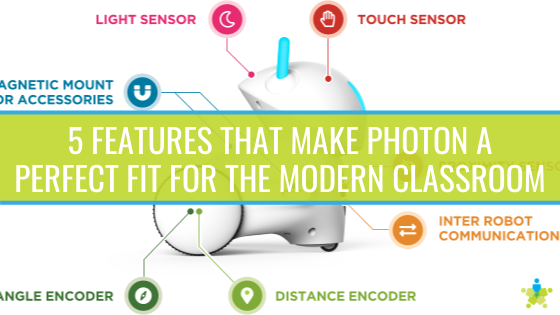How does the Photon fit into the modern classroom?
The Photon is part robot and part lesson plan, designed for students from kindergarten through high school. It’s designed to help students acquire familiarity and competency with STEM-related tasks from an early age. Concepts like coding, logical thinking and troubleshooting are emphasized while using the Photon, but it offers more than just a STEM lesson plan.The U.S., along with the rest of the world, are looking for STEM-focused professionals. According to the Bureau of Labor Statistics, the U.S. may only be able to fill half of its high-skill manufacturing positions over the next 10 years, and that’s just one industry. Across many industries, technological expertise is an emerging critical skill.One obstacle to higher STEM education, though, is the lack of preparedness among high school students. Without the foundational knowledge in place, college STEM majors are more likely to drop out, but the Photon can be one tool teachers use to provide this knowledge.
Five Features That Make the Photon a Valuable Teaching Tool
The Photon is packed with features that allow it to provide an endless number of compelling learning scenarios. Five of those features include:
- Age-appropriate coding and programming - Computer science is the foundation for many growing technologies, and coding is the foundation of computer science. For this reason, Photon places coding and programming at the center of its lesson design. Each lesson, though, is designed for a particular age group, so complexity grows with students.For example, Photon can be used with children who haven’t learned to read yet using visual cues. With Photon Draw, students can use their fingers to draw paths for Photon to follow. This trains students in spatial reasoning and planning. Photon Badge is also for pre-readers and allows students to program Photon’s behaviors using colors and symbols. This trains students in error detection and prediction, both of which are useful skills in veteran engineers.For older elementary and middle school students, Photon Blocks and Code serve as a bridge from visual-only coding to a mix of verbal and visual coding. This allows students to stretch their creativity and capabilities while getting comfortable with advancing coding techniques. At the high school level, Photon can be used to teach students actual coding languages, including Python and Javascript.A single Photon robot can deliver all of this lesson content, which reduces the number of Photons a school will need to acquire to begin teaching its students.
- Versatile interactivity features - The Photon comes laden with sensors, so students can interact with the robot in many ways. It has a sound sensor, light sensor, obstacle sensor, contrast sensor and touch sensor, so it will respond to users no matter how they communicate.These sensors can also be used to drive lessons and get creative with Photon’s capabilities. For instance, Photon can navigate along a black line using its contrast sensor, so students can create paths for Photon to follow. Photon’s sensors can be used to measure distances and angles, respond to other Photons in the room and respond to certain noises. In this way, Photon can be used to introduce mathematical concepts such as geometry and engineering.
- Designed and built to last - The Photon robot is made from sturdy, durable materials that have weight, so it will hold up even in active elementary school classrooms. The Photon’s battery is also designed to last and can provide eight hours of operation before a recharge is needed.Also, with health and safety a major focus for schools, it’s nice to know that the Photon can be easily cleaned with a sanitizing wipe.
- Compatible with an array of devices - The Photon consists of the robot and app, and both can be powered by any device. This includes iOS and Android devices, as well as Windows devices and Chromebooks. The Photon, then, can fit into any school’s larger technological ecosystem.
- Expandable with kits and accessories - The Photon is built for long-lasting educational and edutainment value. In addition to the variety of coding and programming lessons, the Photon can be augmented with magnetic accessories or with learning kits that expand what the robot can do.Photon’s back is magnetized and can be used with a variety of pieces to alter the robot’s look. Students can really stretch their creativity by using their own 3D printed accessories, which are also compatible with the Photon.The Photon’s educational kits, though, give the robot life beyond STEM. In addition to robotics and coding, Photon can also be used to teach physics, ecology and even socio-emotional concepts. Additional kits, including artificial intelligence and early education, are in development and expected to be available soon.Of particular note is Photon’s Special Education kit, which is designed specifically for students who require additional educational support or who are nonverbal.
The Photon robot and app uses child-friendly colors, images and learning methods to introduce students to the complex world of coding and programming. Those are valuable skills to meet professional and creative goals, but Photon’s value goes well beyond its STEM-focused curriculum and tools. The Photon also allows students to work and play together, collaborate on solving problems, develop confidence with technology and learn about a variety of subjects with the help of a versatile robot assistant. For teachers, that versatility can be put to use in engaging students in STEM and beyond.



